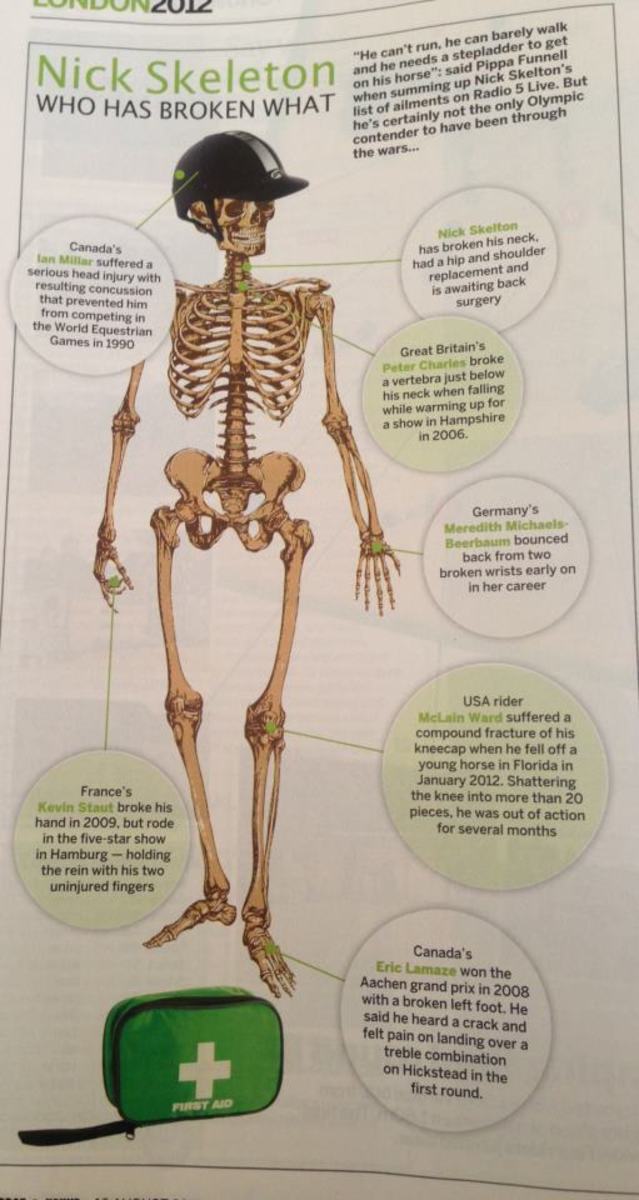I came upon an amazing image on Facebook today that explains just how crazy horse people can be. I thought it would be darkly humorous to come up with a list of the most common horse-related injuries I have experienced to make light of how horse people seem to shrug off the fact that we are working with a massive animal that goes fast, is very tall and has metal-tipped mallets for feet.

This list reminds me that, KNOCK ON WOOD!!!!!, it has been a while since I have hurt myself around horses … OK, so maybe it has only been a year.
1. Eating dirt fall: I think these are the most memorable because you aren’t hurt enough to focus on anything besides the feel of the oh-so-hard ground as your body hits like a ton of bricks. Whether you land mostly on our shoulder or hip, this type of fall tends to end with only a bruised ego and side–nothing a long soak in an Epsom salt bath won’t take care of (note that I am not a doctor and you should not be listening to me for actual medical treatments from an injury).
2. The modified eating dirt (aka, the head slam) fall: This fall is a modification of the straightforward saddle-to-ground fall. In this “dismount” your body lands before your head and then brings your skull with it. Welcome to the world of concussions. The first pony I rode as a kid would dump me (usually just eating dirt) on a very regular basis, so I have been fortunate enough to have developed an early habit of wearing a helmet during every ride. This has worked out well for me, especially when I came off a horse during gymkhana and cracked my helmet in half on a rock (in retrospect, putting your forehead on a bat and spinning a dozen times before mounting a horse and cantering off might not be the safest game).

3. The unusual dismount: This way of injuring yourself is usually the story you tell everyone–whether it is your dismount or someone else’s. It is also cause for some pretty weird injuries. I saw someone mount her horse with so much force that she overshot the saddle and landed on the ground, on the other side. It seemed funny, until the ambulance had to be called in.
I had my own unusual dismount last year, when I was cantering up a hill and got unseated. Having evented for most of my life, I casually decided that an emergency dismount would be easier than the arm strength it would take me to push myself back into the saddle. I landed on my feet and went to get back on, only to realize I had bumped my side on the pommel while dismounting. Once the adrenaline wore off, it became very clear that I had broken more than one rib. I know because this isn’t the first time I have done it from an unusual dismount. Ouch.
Another unusual dismount I had was after mounting a new horse outside the barn. As I got my foot over the saddle, he took off with me and proceeded to jump the massive pile of hay waiting to get loaded into the loft. He immediately spun and headed for the manure truck and barn, so I decided to let go (because the 30 bales of hay weren’t scary?!?). A pommel to the chin, a stirrup to the face and a seat on the stone driveway left me looking and feeling like I had been in a cage fight.
4. The foot stomp: You know you are an equestrian when your horse can step on your foot and you can continue a conversation without skipping more than the breath it takes to ask them to lift their leg off you. Everyone has been stepped on.?Sometimes it doesn’t hurt, other times your horse jumps off a ledge and takes out the back of your foot when he lands. Other times, as in my case, you get yourself into a situation that could have ended in a major hospital visit but instead “thankfully” only results in your leg being used as a spring board for a small horse. Nothing says “equestrian” like a summer with horseshoe-shaped bruise on the back of your leg.
5. The bite: A grey mare named Tabitha taught me that a horse’s front is not always the safer end. After I tightened her girth too quickly, she returned the favor by having a go at my side. Getting a horse bite on your rib cage is the exterior equivalent of breaking ribs. I would say that I have never felt such pain from a horse, had I not had another horse bite me on the shoulder. I say on, but I really mean she took my entire shoulder muscle in her mouth and clamped down. I don’t think Winston Churchill had a horse’s teeth in mind when he said that the outside of a horse is good for the inside of a man, because every time a horse has bitten me I have cried like a baby. I am not talking about just tears, I have to sit down and sob.
So I have shared my list. Do you have your own? Post them in the comments below!











